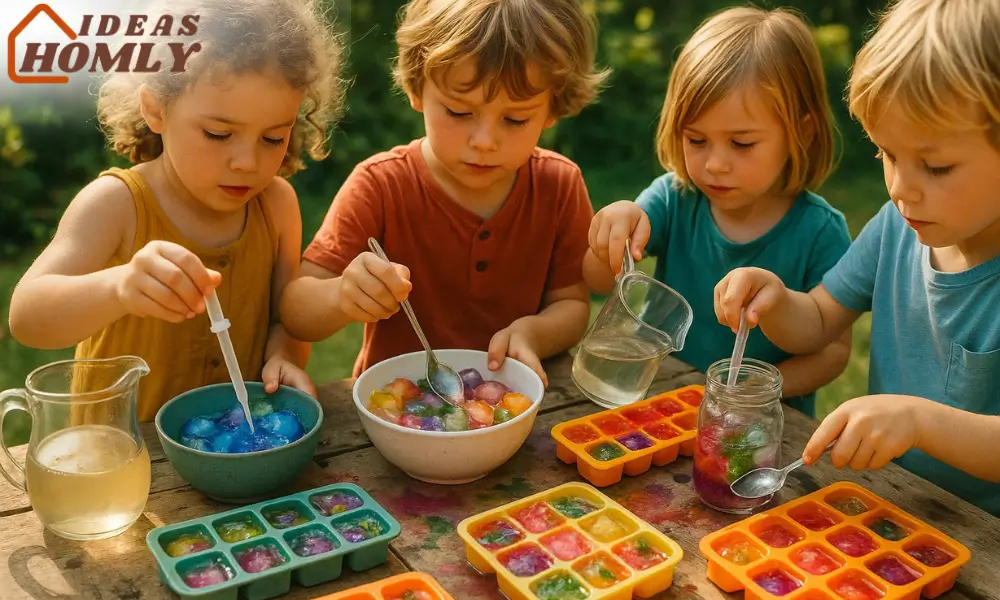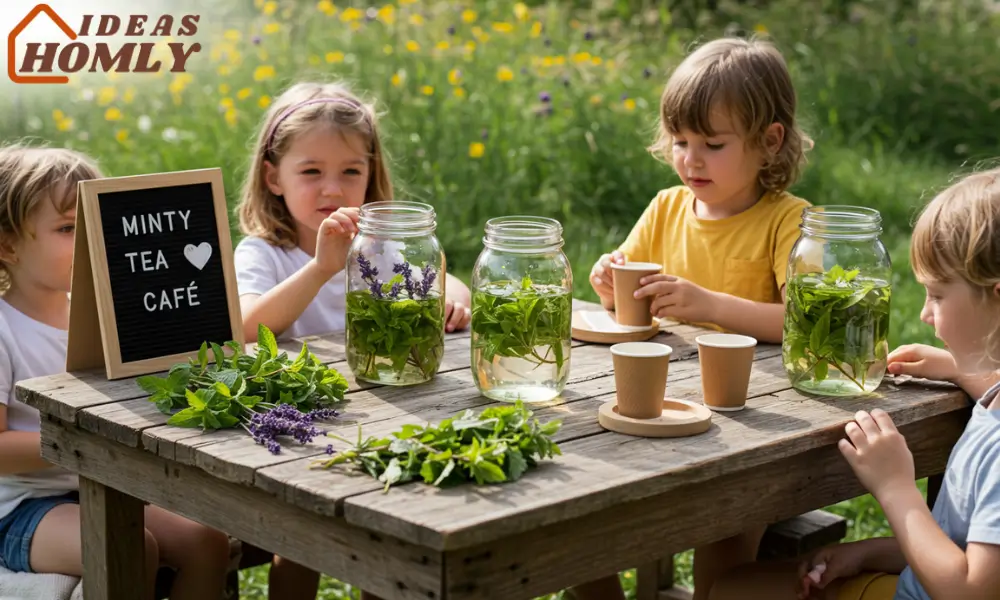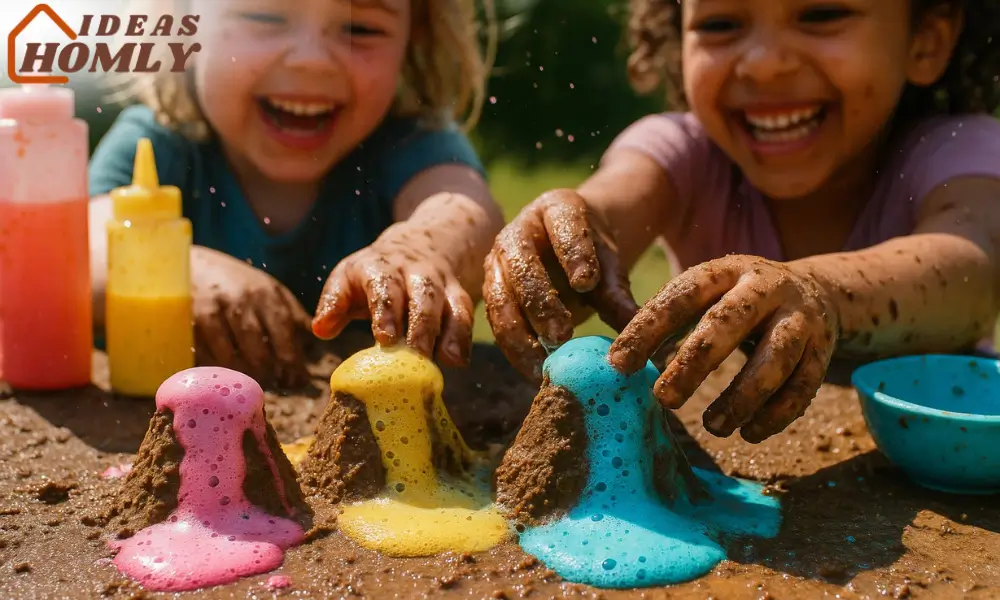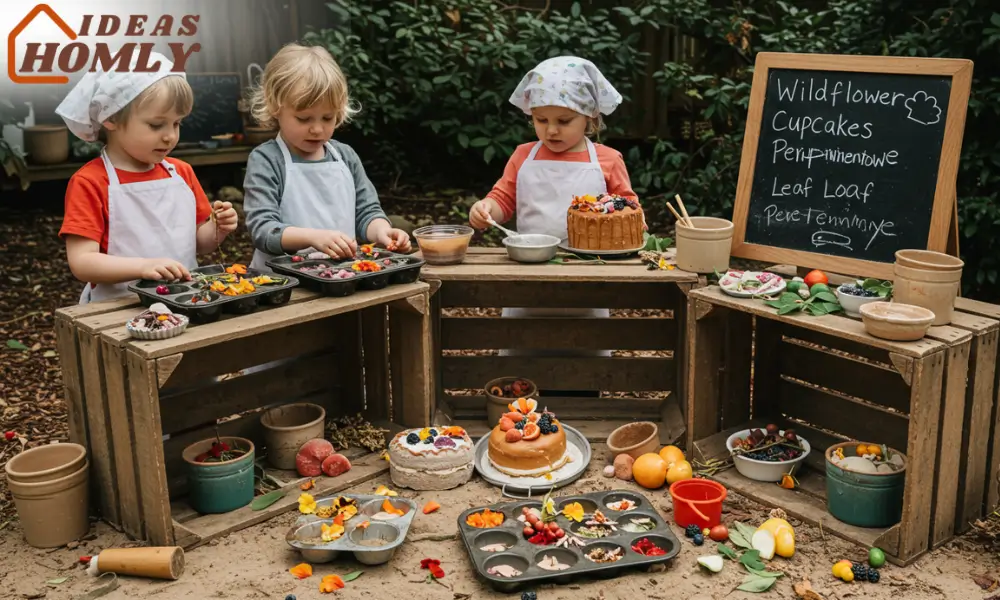When the summer heat kicks in, nothing beats messy outdoor fun with a mud kitchen. As someone who’s been passionate about home activities and creative play for years, I can tell you mud kitchens are more than just playtime.
They spark imagination, connect kids with nature, and give you a break while they stay entertained for hours.
What is a Mud Kitchen?
A mud kitchen is a DIY outdoor play space where kids pretend to cook using mud, water, sand, flowers, leaves, and anything else they find outside.
It usually includes old pots, pans, ladles, mixing bowls, and a setup that resembles a rustic kitchen. Some families build elaborate wooden versions, while others use crates or even old tables and plastic tubs.
What I love most is how budget-friendly and easy it is to create. You don’t need a fancy setup just some creative thinking and a corner of your yard. It’s the kind of play that feels timeless, earthy, and hands-on. It’s a little messy, yes but it’s worth every bit of it.
Why Mud Kitchens Are Perfect for Summer Play?
Summer gives kids long days, warm weather, and endless reasons to stay outside. Mud kitchens tap into their curiosity and help burn off that summer energy in a positive way. Here’s why I believe every home with kids needs one:
- Sensory play: Kids explore textures, temperatures, smells, and colors.
- Free play: They get to lead the play without screens or rules.
- Nature connection: Using soil, leaves, herbs, and flowers brings them closer to the environment.
- Affordable fun: You don’t need to buy anything new. Reuse what you have.
- Creative development: They invent recipes, create “potions,” and mimic what they see in your real kitchen.
For me, it’s a summer win every single year. And over time, I’ve tried dozens of activities. Below are five of my top mud kitchen ideas for summer each one tested, tweaked, and toddler-approved.
1. Ice-Cube Potion Bar
Cool Science and Imagination in One
This is one of the most loved ideas at our place, especially on those really hot afternoons. The ice-cube potion bar is all about mixing cold, colorful potions using melting ice cubes, nature bits, and safe kitchen ingredients.
I usually prep a batch of colored ice cubes the night before. I use silicone molds to freeze water mixed with food coloring, flower petals, mint leaves, or even small lemon slices. Then I set them out in bowls with old ladles, bottles, and cups.

How to Set It Up:
- Freeze water with colors or natural items like basil or rosemary.
- Provide bowls of warm water, spoons, pipettes, and jugs.
- Add baking soda and vinegar nearby for fizz and surprise.
The kids mix, stir, and swirl their “magic brews,” watching the ice melt and colors blend. It’s part sensory, part science, and entirely fun. It keeps them occupied without the need for constant supervision.
Tip: Use a plastic table cover or tray to catch the mess and make cleanup easier.
2. Solar-Brewed Mint “Tea Café”
Pretend Café with Real Herbal Fun
This idea started as a pretend tea party and turned into a full-on backyard solar tea café. We pick fresh herbs from the garden mostly mint, lavender, and lemon balm. Then the kids pour warm water into jars filled with herbs and let the sun do its work.
After about an hour in the sun, the herbal scent fills the air, and the pretend tea café is open for business.
What You’ll Need:
- Clean jars or pitchers
- Fresh herbs (mint is perfect for beginners)
- Spoons, strainers, and paper cups
- Signs like “Minty Café” or “Fresh Garden Teas” (optional)
They pour, stir, and serve each other like real baristas. It’s a wonderful way to introduce kids to the idea of slow, sensory-based play, and also gets them learning about herbs in a very casual way.
I often bring out a picnic rug nearby and join in with a real cup of tea it’s one of those peaceful summer parenting moments I cherish.

3. Color-Fizz Volcano Mounds
Messy, Colorful Science in the Mud Kitchen
This one’s a favorite with every child who’s visited our backyard. The color-fizz volcano combines mud mounds with fizzy science reactions that feel like mini backyard eruptions. It’s both educational and wild fun.
We start by building little mud volcanoes, cone-shaped mounds that are hollowed out at the center. Then I let the kids choose food coloring to drop inside. I usually keep squeeze bottles of vinegar ready, along with a jar of baking soda nearby.
Simple Supplies I Use:
- Mud for shaping (use wet dirt or clay)
- Baking soda in a bowl or cup
- Vinegar in squeeze bottles
- Natural dyes or food coloring
- Old spoons and bowls
They add baking soda first, then a splash of vinegar, and watch the fizz overflow like lava. The colors blend, bubbles rise, and the excitement is real every time. It’s a fantastic mix of creative play and hands-on science.

Add a few drops of essential oils like orange or lemon to make it smell amazing too. This works great for sensory play while keeping it fresh outdoors.
4. Wet-Sand Bakery Station
Who doesn’t love a good pretend bakery? I set up our wet-sand bakery with old cake pans, muffin trays, and scoops. It’s a go-to idea whenever the kids want to “bake” without me turning on the oven.
The base material is wet sand perfect for molding and shaping. Sometimes I add flour to make it softer and stickier. Then they decorate their “cupcakes” and “cakes” with flower petals, small pebbles, leaves, and even wild berries we collect during walks.
Here’s What I Include in the Setup:
- Mixing bowls and scoops
- Measuring cups (they love this!)
- Old bakeware (trays, tins, molds)
- Nature finds like petals and leaves
The best part? They get to pretend-play just like they’ve seen in the kitchen. It’s creative, hands-on, and even good for learning early math with measuring and dividing.

I often join in and pretend to be their customer. It becomes a full bakery roleplay, complete with prices, menus, and sometimes even a chalkboard sign. It’s one of the easiest and most imaginative mud kitchen summer ideas I’ve ever tried.
5. Nature Popsicle Stand
Cooling Down with Creative Pretend Treats
On really hot days, we take our mud kitchen into popsicle mode. I bring out small plastic molds, silicone trays, and even paper cups to create a pretend nature popsicle stand.
The kids fill them with water, flower petals, mint sprigs, grass blades, and even a bit of colorful sand or mud. Then we pop them into the freezer (or leave them in the shade if the weather allows) and later use them for cooling play.
Supplies That Work Best:
- Silicone molds or small paper cups
- Natural add-ins (flowers, herbs, leaves)
- Water and spoons
- Popsicle sticks or twigs
We call out flavors like “mint-mud swirl” or “daisy-leaf crunch,” and play stand-style games. It’s pretend play with a cooling twist and keeps them hydrated too.
It’s also a great conversation starter when friends visit. Everyone wants to join the popsicle business!

Safety & Clean-Up Tips for Parents
As much as I love the mess and creativity of mud kitchen fun, safety is always top of mind. Here are a few tips I follow to keep things clean, safe, and easy to manage—even on the busiest summer days.
- Use non-toxic materials: Only allow edible or safe natural items like herbs, sand, and mud that hasn’t been chemically treated.
- Set up a hand-washing station: I keep a big jug of water, a towel, and soap outside. This encourages kids to wash their hands before and after play.
- Create a mud zone: I use old bedsheets, rubber mats, or plastic tablecloths under the mud kitchen area to make cleanup faster.
- Avoid glass and sharp tools: Stick to plastic or metal utensils. No real knives or breakable dishes.
- Have play clothes ready: I keep a “mud kitchen outfit” for each child so I don’t worry about stains on everyday clothes.
For clean-up, I usually hose down the area or let things dry and sweep them up later. The kids love helping too, especially if it feels like part of the game.
Conclusion
Every summer, the mud kitchen becomes our little outdoor haven. It’s where creativity thrives, boredom disappears, and giggles echo across the yard. Whether it’s brewing minty tea, sculpting muddy cupcakes, or watching fizzy volcanoes explode, this kind of play feels priceless.
I’ve tried every activity above with my own kids (and their friends), and I can say they’re not just fun they’re packed with learning, imagination, and nature.
If you’re looking for a budget-friendly, screen-free, hands-on summer activity that your kids won’t outgrow in a week, a mud kitchen is it. These five ideas are just the start. Add your own twist, let the kids lead, and see where the messy magic takes you.
FAQs
From toddlers to school-age kids, mud kitchens work for a wide range. I’ve seen three-year-olds enjoy scooping and mixing, while older kids create complex games and recipes. It all depends on how you guide the setup and encourage open-ended play.
Not necessarily. While outdoor space helps, even a balcony or shared courtyard can work. Use storage tubs, crates, or water tables. Just make sure it’s a place you don’t mind getting a bit messy, and clean up is easy with a water bucket or hose.
I started mine with an old table, some plastic bowls, and garden soil. Check thrift stores or reuse kitchen items you no longer need. Wooden pallets, crates, and even plant pots work great. Focus on function, not looks.
Keep food scraps out of the setup. If you’re using herbs or fruits, store them inside when done. Lavender and mint are natural bug repellents and great for sensory play. Regular clean-up and dry storage also help prevent bugs.
Absolutely. Mud kitchens support fine motor skills, sensory exploration, communication, and problem-solving.
They also encourage independent thinking and storytelling. In my experience, kids become calmer, more focused, and incredibly imaginative when given space to explore through messy play.

